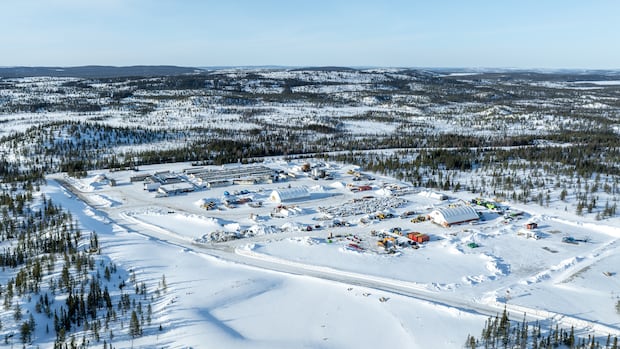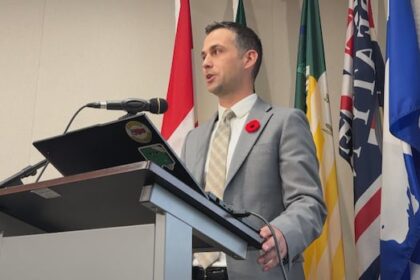NorthPMET Resources and the Shaakichiuwaanaan Project set up a base to extract lithium about 330 kilometres east from Chisasibi and Wemindji, the nearest Cree communities.Shaakichiuwaanaan Project would be the second largest lithium mine globally, says CEOVanna Blacksmith · CBC News · Posted: Oct 20, 2025 2:14 PM EDT | Last Updated: 5 hours agoBase camp of the Shaakichiuwaanaan Mining Project, a proposed lithium mine in northern Quebec. If authorized, PMET Resources said it could be the second largest lithium mine in the world. (Submitted by PMET Resources)PMET Resources has set up a base to extract lithium as it advances its plan to build what could be the second largest lithium mine in the world situated on Cree territory.The mining company’s proposal for the Shaakichiuwaanaan Mining Project would see the mine built about 330 kilometres east from Chisasibi and Wemindji.In Cree, Shaakichiuwaanaan translates to climbing hills together, and it was chosen as a rebrand for the mine based on numerous consultations with the Cree.If authorized, it will be the third lithium mine in Eeyou Istchee, following the Whabouchi Project east of Nemaska, and the Moblan Project 80 kilometres northwest of Mistissini. Edward Bearskin, a Cree community member from Chisasibi and liaison coordinator for PMET Resources, acknowledged that while the project may bring new opportunities, it also comes with challenges for traditional land users.“Whenever there’s construction around a certain area where people go to hunt, there are impacts through practicing your culture,” said Bearskin.He also hopes the Shaakichiuwaanaan Mining Project will bring opportunities for local involvement and long-term benefits for Cree people.“There are certain expertise that will be needed, I hope to see our people being trained in this in the future,” he said.“I do hope to see a lot of people getting their licences for heavy trucks. There will be a lot of hauling. There will also be a lot of civil works that will need to be done.”Edward Bearskin is Cree from Chisasibi and is the liaison coordinator for PMET. He’s hopeful the project can provide benefits to local communities. (Submitted by PMET Resources)Ken Brinsden, the CEO and managing director of PMET Resources, said this could be one of the biggest mines in the world. “If it was in production today, it would actually be about the second largest globally,” he said, adding that roughly 20 percent of the jobs created will be allotted to Cree employees, which may vary between truck drivers, cooks, among others.According to Shaakichiuwaanaan Mining Project researchers, the site could yield up to 800,000 tonnes of lithium-rich rock per year, along with pollucite, tantalite, and cesium — metals that are also essential to modern technology.Lithium, a key component in electric and hybrid vehicle batteries, medical imaging, and energy storage systems, is in increasing demand worldwide.Brinsden believes putting more effort into lithium-powered energy can play a part in minimizing the impact of climate change. The first phase will involve open-pit mining, followed by underground operations.Brinsden said his company has been consulting with community members and elders every three months on the project.“It’s fair to say that like every community engagement, there’s always questions, questions about the project and what its impacts might be,” he said.Their project report highlights potential environmental impacts such as noise effects on fish and migratory birds, reduced air quality, habitat loss, restricted access for traditional activities, and damage to archaeological sites.The impacts and benefits agreement with the Cree is not yet finalized and publicly available. Ken Brinsden is the CEO and directing manager of PMET Resources, a Canadian exploration company. He believes focusing on lithium-powered energy can help mitigate climate change. (Submitted by PMET Resources)Brinsden says that minimizing environmental impact remains a long-term priority through careful closure planning.“The closure plan is pretty definitive as to what’s required in respect of the work to be done, but also the money is being allocated to ensure that the closure plan is enacted,” he said.Representatives of the Impact Assessment Agency of Canada, the Cree Nation government, and PMET Resources are hosting public sessions this week in Chisasibi, where community members can ask questions about the proposed project and its potential impact on the land. PMET Resources will also host a two-day workshop in Chisasibi, starting Monday, to introduce the Shaakichiuwaanaan Mining Project and possible careers. Brinsden said PMET Resources’ next step is to submit its environmental and social impact assessment, together with its feasibility study, to the government of Canada within the two months. Once submitted, the company will await final authorizations before beginning extraction.LISTEN | Edward Bearskin of PMET Resources explains the Shaakichiuwaanaan lithium project:Eyou Dipajimoon (Cree)15:42Edward Bearskin of PMET Resources explains the Shaakichiuwaanaan lithium projectRepresentatives of PMET Resources — formerly known as Patriot Battery Metals — are planning to visit Chisasibi later in October. They are moving forward with plans to build a mine at the Shaakichiuwaanaan site on the Transtaiga Highway. We spoke with the company’s community liason coordinator, Edward Bearskin, about what this might mean for the people of Chisasibi.ABOUT THE AUTHORVanna Blacksmith is an Eenou-Anishinaabe award winning journalist from the Cree Nation of Mistissini, works with CBC Cree in Montreal. They share stories from across Eeyou Istchee and northern Quebec, with a passion for covering sports, community, Cree culture, health, and the arts. Story ideas can be sent vanna.blacksmith@cbc.ca
Wednesday, 17 Dec 2025
Canada – The Illusion
Search
Have an existing account?
Sign In
© 2022 Foxiz News Network. Ruby Design Company. All Rights Reserved.
You May also Like
- More News:
- history
- Standing Bear Network
- John Gonzalez
- ᐊᔭᐦᑊ ayahp — It happened
- Creation
- Beneath the Water
- Olympic gold medal
- Jim Thorpe
- type O blood
- the bringer of life
- Raven
- Wás’agi
- NoiseCat
- 'Sugarcane'
- The rivers still sing
- ᑲᓂᐸᐏᐟ ᒪᐢᑿ
- ᐅᑳᐤ okâw — We remember
- ᐊᓂᓈᐯᐃᐧᐣ aninâpêwin — Truth
- This is what it means to be human.
- Nokoma











